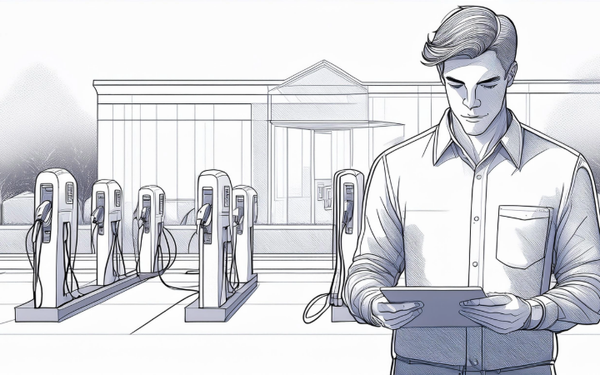Essential Software for Charge Point Operators
Charge Point Operators (CPOs) require a robust suite of software tools to efficiently manage their network. We describe the essential software components that CPOs need to successfully operate and grow.

Charge Point Operators (CPOs) require a robust suite of software tools to efficiently manage their network of electric vehicle (EV) charging stations. These tools encompass various functionalities that aid in site management, maintenance, customer service, and operational efficiency. Below, we describe the essential software components that CPOs need to successfully operate and grow their charging infrastructure.
1. Network Management Software
This is the backbone of any CPO’s software suite, providing centralized control over the entire charging network.
- Site Monitoring and Management: Real-time monitoring of charging stations to ensure they are operational. This includes status updates, fault detection, and remote diagnostics to troubleshoot issues without physical intervention.
- Load Management: Balances the electrical load across multiple charging stations to prevent overloading and to optimize energy distribution. This is crucial for sites with limited electrical capacity.
- Data Analytics: Collects and analyzes data on usage patterns, peak times, and user behavior. This helps CPOs make data-driven decisions for optimizing the location and number of charging stations.
2. Customer Relationship Management (CRM) System
A CRM system is essential for managing interactions with customers and providing high-quality customer service.
- User Accounts and Memberships: Manages user profiles, subscription plans, and loyalty programs. This includes tracking usage history, billing, and payments.
- Customer Support: Integrates with customer service channels (phone, email, chat) to handle inquiries, complaints, and technical support efficiently.
- Feedback and Surveys: Collects user feedback and conducts surveys to understand customer satisfaction and areas for improvement.
3. Mobile Applications
Mobile apps provide a user-friendly interface for EV drivers, enhancing their charging experience and engagement with the CPO’s services.
- Station Locator: Helps users find nearby charging stations, providing details like availability, pricing, and type of charger.
- Reservation System: Allows users to reserve charging slots in advance, reducing wait times and improving user satisfaction.
- Payment Processing: Facilitates secure and convenient payment options, including credit cards, mobile wallets, and subscription billing.
- Real-Time Notifications: Sends alerts about charging status, station availability, and promotional offers.
4. Billing and Payment Systems
Efficient billing and payment processing are critical for revenue management and customer satisfaction.
- Tariff Management: Supports various pricing models, including pay-per-use, subscription plans, and dynamic pricing based on demand.
- Invoicing and Receipts: Generates detailed invoices and receipts for users, which can be accessed via email or the mobile app.
- Payment Gateway Integration: Ensures secure transactions through integration with multiple payment gateways, supporting credit/debit cards, mobile payments, and other digital payment methods.
5. Maintenance Management Software
Regular maintenance is vital to ensure the reliability and longevity of charging stations.
- Scheduled Maintenance: Automates the scheduling of regular maintenance tasks based on usage data and manufacturer recommendations.
- Fault Management: Logs faults and issues, prioritizes them based on severity, and tracks resolution progress.
- Inventory Management: Keeps track of spare parts and maintenance supplies to ensure timely repairs and minimize downtime.
6. Energy Management Systems
Efficient energy management helps optimize operational costs and supports sustainability goals.
- Demand Response: Adjusts charging load in response to grid signals to take advantage of lower electricity rates or to reduce strain on the grid during peak times.
- Renewable Energy Integration: Manages the integration of renewable energy sources, such as solar panels, to power the charging stations.
- Energy Storage Management: Utilizes battery storage systems to store excess energy and deploy it during high-demand periods or power outages.
7. Fleet Management Software
For CPOs that manage fleets of EVs (e.g., car-sharing or rental services), fleet management software is crucial.
- Fleet Tracking: Monitors the location, status, and charging needs of the entire fleet in real-time.
- Charge Scheduling: Optimizes charging schedules to ensure vehicles are charged and ready for use while minimizing energy costs.
- Utilization Analytics: Provides insights into fleet usage patterns to optimize the number of vehicles and charging stations needed.
8. Cybersecurity Solutions
As CPOs deal with sensitive user data and financial transactions, robust cybersecurity measures are essential.
- Data Encryption: Ensures that all user data and transaction information are securely encrypted both in transit and at rest.
- Access Control: Implements strict access controls to prevent unauthorized access to the network and systems.
- Threat Detection and Response: Monitors for potential security threats and provides tools for rapid response to mitigate any breaches.
Conclusion
To operate effectively and sustainably, Charge Point Operators must leverage a comprehensive suite of software tools that cover network management, customer service, billing, maintenance, energy management, and cybersecurity. By investing in these technologies, CPOs can enhance their operational efficiency, provide superior service to EV drivers, and capitalize on the growing demand for EV charging infrastructure.





